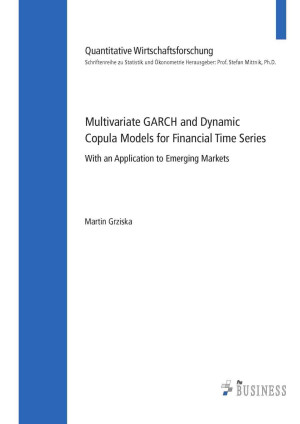Multivariate GARCH and Dynamic Copula Models for Financial Time Series
- Autor*in: Grziska, Martin
- Verlag: Westarp BuchShop
- ISBN:978-3-86386-843-7
✓ Auf Lager – Versandfertig in 1-2 Werktagen
20,00 €
inkl. MwSt, zggl. Versandkosten
Über den Titel
This thesis presents several non-parametric and parametric models for estimating dynamic dependence between financial time series and evaluates their ability to precisely estimate risk measures. Furthermore, the different dependence models are used to analyze the integration of emerging markets into the world economy. In order to analyze numerous dependence structures and to discover possible asymmetries, two distinct model classes are investigated: the multivariate GARCH and Copula models. On the theoretical side a new dynamic dependence structure for multivariate Archimedean Copulas is introduced which lifts the prevailing restriction to two dimensions and extends the multivariate dynamic Archimedean Copulas to more than two dimensions. On this basis a new mixture copula is presented using the newly invented multivariate dynamic dependence structure for the Archimedean Copulas and mixing it with multivariate elliptical copulas. Simultaneously a new process for modeling the time-varying weights of the mixture copula is introduced: this specification makes it possible to estimate various dependence structures within a single model. The empirical analysis of different portfolios shows that all equity portfolios and the bond portfolios of the emerging markets exhibit negative asymmetries, i.e. increasing dependence during market downturns. However, the portfolio consisting of the developed market bonds does not show any negative asymmetries. Overall, the analysis of the risk measures reveals that parametric models display portfolio risk more precisely than non-parametric models. However, no single parametric model dominates all other models for all portfolios and risk measures. The investigation of dependence between equity and bond portfolios of developed countries, proprietary, and secondary emerging markets reveals that secondary emerging markets are less integrated into the world economy than proprietary. Thus, secondary emerging markets are moresuitable to diversify a portfolio consisting of developed equity or bond indices than proprietary.Eigenschaften
| Gewicht: | 260 g |
|---|---|
| Erscheinungsdatum: | 04.02.2015 |

